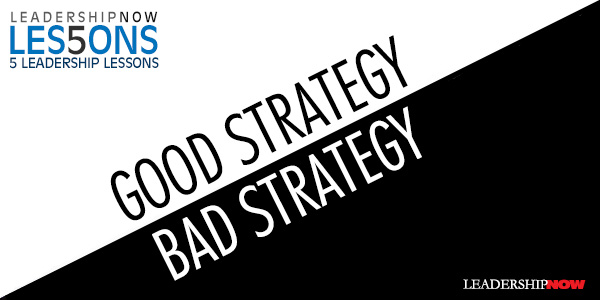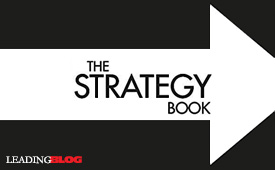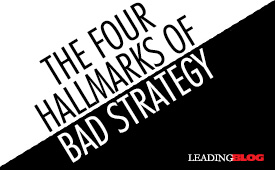5 Leadership Lessons: Good Strategy, Bad Strategy

RICHARD RUMELT has written an insightful book on developing the ability to identify and develop good strategy. Good Strategy, Bad Strategy is obviously the result of decades of practice developing strategy and the many case studies and classroom interactions made it personal and very readable.
We’ve all been there. The big conference room as the lights dim and the PowerPoint slides begin. We sit attentively as the leader steps to the podium to tell us something like: “Going forward we will attain global leadership in our markets, increase revenues and profits ten percent, rationalize our supply chain and eat the competition’s lunch by taking huge chunks of market share—all based on one of the world’s most highly talented workforces for whom success is never quitting until you win.”
Cue the Chariots of Fire soundtrack, roll the reel of the good-looking diverse people of the company, and unleash the balloons.
There’s a lot going on here: This leader is visionary, ambitious, goal-oriented, and motivational. Whether it is putting a man on the moon, fighting a war, launching a new product or responding to changing market dynamics such as the publishing industry’s transition from paper to pixels, what he or she is articulating is NOT a strategy for overcoming obstacles to progress.
When it comes to strategy, we have gotten off-track into thinking that fluffy platitudes, goals, motivational slogans, and wishful thinking are the same thing as strategy. As a result, we don’t get the intended results. “Bad strategy,” says Rumelt, occurs when there is bad doctrine, when hard choices are avoided, and/or when leaders are unwilling or unable to define and explain the nature of the challenge.
Here are some key ideas from this classic on strategy:
 A great deal of strategy work is trying to figure out what is going on. Not just deciding what to do, but the more fundamental problem of comprehending the situation. A good strategy honestly acknowledges the challenges being faced and provides an approach to overcoming them. Strategy must contain action. Winging it is not a strategy.
A great deal of strategy work is trying to figure out what is going on. Not just deciding what to do, but the more fundamental problem of comprehending the situation. A good strategy honestly acknowledges the challenges being faced and provides an approach to overcoming them. Strategy must contain action. Winging it is not a strategy.
 A talented leader identifies the one or two critical issues in the situation—the pivot points that can multiply the effectiveness of effort—and then focuses and concentrates action and resources on them.
A talented leader identifies the one or two critical issues in the situation—the pivot points that can multiply the effectiveness of effort—and then focuses and concentrates action and resources on them.
 Organizations experience significant entropy—the continual drift towards disorganization. Much of the useful work of managers and consultants is maintenance—the constant battle against entropy. Strategists must battle this never-ending drift towards disarray within their own organization. And they must try to exploit the disarray of their rivals.
Organizations experience significant entropy—the continual drift towards disorganization. Much of the useful work of managers and consultants is maintenance—the constant battle against entropy. Strategists must battle this never-ending drift towards disarray within their own organization. And they must try to exploit the disarray of their rivals.
 Every organization faces a situation where the full complexity and ambiguity of the situation is daunting. An important duty of any leader is to absorb a large part of that complexity and ambiguity, passing on to the organization a simpler problem—one that is solvable.
Every organization faces a situation where the full complexity and ambiguity of the situation is daunting. An important duty of any leader is to absorb a large part of that complexity and ambiguity, passing on to the organization a simpler problem—one that is solvable.
 A good strategy has, at a minimum, three essential components: a diagnosis of the situation, the choice of an overall guiding policy, and the design of coherent action. Many attempts at strategy lack a good diagnosis. As the star of most consulting engagements, the client wants an appraisal of a particular course of action or wants advice on what to do. I almost always back up and try to create a better diagnosis of the situation before getting into recommendations.
A good strategy has, at a minimum, three essential components: a diagnosis of the situation, the choice of an overall guiding policy, and the design of coherent action. Many attempts at strategy lack a good diagnosis. As the star of most consulting engagements, the client wants an appraisal of a particular course of action or wants advice on what to do. I almost always back up and try to create a better diagnosis of the situation before getting into recommendations.
* * *

Like us on
Instagram and
Facebook for additional leadership and personal development ideas.
* * *




Posted by Michael McKinney at 06:49 PM
Permalink
| Comments (0)
| TrackBacks (1) | This post is about General Business
, Management










